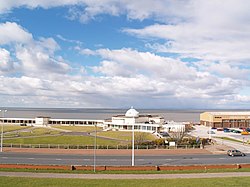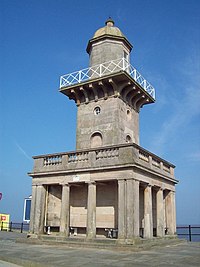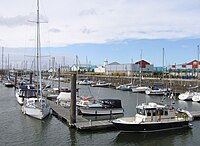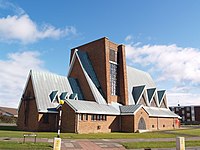Fleetwood
| Fleetwood | |
| Lancashire | |
|---|---|
 Fleetwood — The Marine Hall and Gardens from the Mount | |
| Location | |
| Grid reference: | SD333479 |
| Location: | 53°55’23"N, 3°-0’54"W |
| Data | |
| Population: | 26,840 (2001) |
| Post town: | Fleetwood |
| Postcode: | FY7 |
| Dialling code: | 01253 |
| Local Government | |
| Council: | Wyre |
| Parliamentary constituency: |
Lancaster and Fleetwood |
Fleetwood is a seaside resort town on the coast of Lancashire, at the northwest corner of the Fylde. It stands in and fills the spit of land between the Irish Sea and the River Wyre, which thus enters the sea here. Fleetwood had a population of 26,840 people at the 2001 Census. Fleetwood toay forms part of the “Greater Blackpool” conurbation.
Fleetwood is eight miles north of Blackpool but the townscape runs along the coast to join the two. The town itself is on a peninsula almost two miles wide, bounded to the west by the Irish Sea, to the north by Morecambe Bay, and to the east by the River Wyre. Access to Fleetwood is thus restricted, and for many years there were only two roads into and out of the town. A large sandbank, the North Wharf, extends some two and a quarter miles north into Morecambe Bay, and is exposed at low tide. The river channel forms the eastern boundary of the bank. Together with the larger Bernard Wharf on the other side of the river, this makes navigation of the river difficult. Conversely, the port is highly sheltered from the prevailing westerly winds.
The town was the first planned community of the Victorian era and was named for by founder, Peter Hesketh-Fleetwood. For most of the 20th century, Fleetwood was a prominent deep-sea fishing port, but, since the 1970s, the fishing industry has declined precipitously and the town has undergone economic difficulties. Fleetwood is also a seaside resort, serving as a quiet contrast to nearby Blackpool.
Contents
History
There is evidence that the eastern side of the River Wyre was occupied during the Viking invasions of the 9th and 10th centuries. By the time of the Domesday Book in 1086, the land on which Fleetwood now stands was part of the Amounderness Hundred.
A manor house at present-day Rossall, in the southwest of the town, was in the possession of the Allen family by the time of Henry VIII. The Allens were prominent Roman Catholics, and Henry VIII repossessed the land. Cardinal William Allen was born at the manor house in 1532. The estate was ultimately sold to Thomas Fleetwood, comptroller of the Royal Mint, whose son Edmund, expanded the house into Rossall Hall. The land remained in the Fleetwood family for 300 years.
Foundation of a new town
By the 1830s, the house and estate was in the ownership of Edmund's descendant Peter Hesketh, High Sheriff of Lancashire and Member of Parliament for Preston. A man of somewhat liberal views for his time, Hesketh believed that the sheltered harbour and views over Morecambe Bay gave the area the makings of a busy sea port and popular resort for the less-affluent. With no rail link yet between London and Glasgow, he envisaged Fleetwood as the transfer point between the rail and the steamers to the Clyde, and set about encouraging a railway link from Preston. With a new career in Parliament to prepare for, he engaged Frederick Kemp as his agent. He originally considered naming the new town Wyreton or New Liverpool, but after changing his name to Peter Hesketh-Fleetwood in 1831, he settled on the name Fleetwood. After some delays, he hired the prominent architect Decimus Burton, whose work in St Leonard's-on-Sea he had admired, to lay out what would be the first planned town of the Victorian era. The plans were complete by 1835, and construction of the first buildings and the railway line began in 1836.
Burton's plan was to use the largest of the sand-dunes on the north-facing shore as the focus of a half-wheel street layout. This was landscaped, and became known as The Mount. It served as the hub of Burton's half-wheel design, the main residential streets acted as the spokes, and the main commerce area of Dock Street was the rim of the wheel. The oldest surviving building in the town, once the custom house, later the town hall, and latterly Fleetwood Museum, dates from 1836 and housing from as early as 1838 still exists in the town. The crown jewel was the North Euston Hotel, built in 1841, a fine semi-circular building overlooking the bay and the river's estuary. The hotel was built to serve overnight guests making the railway journey from Euston, and was close to the point of departure for the steamers to the Clyde. This journey was made by Queen Victoria in 1847, but by the mid-1850s the completion of the western railway link between London and Glasgow over Shap Fell rendered Fleetwood's role as a transport terminus obsolete.
Burton designed two lighthouses for the town: The Upper Lighthouse, usually referred to as the Pharos (after the Pharos of Alexandria in Egypt, one of the Seven Wonders of the Ancient World), can be seen for 13 miles, and Beach Lighthouse is visible for 9 miles. Both opened in 1840. A third lighthouse, Wyre Light, built in 1839-40 by blind engineer Alexander Mitchell, offshore on the northeast corner of North Wharf, was the first screw pile lighthouse to be built in Great Britain. Fleetwood is the only town in the United Kingdom to possess three lighthouses and the two within the town itself remain fully operational. Wyre Light has now fallen into a state of disrepair.
Fleetwood Market, still a prominent permanent market, first opened in 1840.
By 1838, Hesketh-Fleetwood had run into serious financial difficulties, with costs for the railway in particular ultimately exceeding £300,000. He had numerous financial arguments with Frederick Kemp, who borrowed against the estate revenues to finance the expansion of the town, and was suspected of taking financial advantage of Sir Peter. Hesketh-Fleetwood became short of cash and was forced to mortgage his properties. Depressed, he gradually withdrew from the project, and by 1844 he had been obliged to sell much of his estate. He leased Rossall Hall itself to the Church of England, which intended to set up a boarding school as a Lancashire equivalent of Marlborough School (Woodstock) and under the auspices of Rev St Vincent Beechey, the vicar of Fleetwood, it was to become Rossall School. Virtually bankrupt, Hesketh-Fleetwood retired to Brighton, giving up his parliamentary obligations in 1847. Meanwhile, Kemp's influence expanded. He had set up the Fleetwood Estates Company to manage the land, and the North Lancashire Steam Navigation Company in 1843 to manage the expanding steamer trade. However, by the late 1850s, the combination of the new western railway route and the rise of neighbouring Blackpool as a prominent seaside resort signalled a decline in the town's fortunes.
After Hesketh-Fleetwood
From the 1860s Fleetwood expanded its port activities. Steamers began pleasure and commercial services to the Isle of Man, Ardrossan and Belfast. Half a mile of stone quays was built along the river front, and the railway line was extended to the steamer pier opposite Queen's Terrace, where the imposing new railway station was built in 1883. The port was still mainly a cargo terminal at this time, but the fishing industry began to grow as vessels expanded their fisheries from the Irish Sea fishing grounds to the haddock grounds of the North Atlantic Ocean. At this time, all the fishing vessels out of Fleetwood were sail-powered fishing smacks, few being over 40 tons deadweight. The Fleetwood Docks Act of 1864 enabled the construction of a dock and embankment for both fishing and general cargo. Work on what was to become Wyre Dock began in 1869 but was suspended for financial reasons. A second Act in 1871 gave construction authority to the Lancashire and Yorkshire Railway Company, under chief engineers Sir John Hawkshaw and Harrison Hayter. Construction itself, by John Aird & Sons, was completed in 1877. Heavy industry came to the area in the late 1880s with the construction of a salt-processing works on the southeastern edge of the town by the Fleetwood Salt Co. Ltd, using salt mined in Preesall, across the river.
By the early 1890s, Fleetwood declined as a port in the face of rival cargo ports in Lancashire and Cumberland and the Manchester Ship Canal, but this was more than offset by a period of rapid expansion of the fishing industry, signalled by the launch in 1891 of the first steam powered trawler, the Lark. All the other major fishing ports in Britain, Hull, Grimsby and Aberdeen, were on the east coast, so there was a competitive advantage for a west-coast port with good rail links. By the start of the 20th century, Fleetwood's position as one of the three major fishing ports was cemented. James Marr brought a fleet of steam trawlers to Fleetwood and actively started to change the port by selectively fishing for hake, which until then had been treated as a much less desirable catch. Many of the houses in the old area of town around the Mount and Lord Street were built in the 1890s.
In keeping with the thriving economy, these terraced houses were large for their era. An electric tramway link to Blackpool was constructed in the 1890s and remains operational to this day. The trams were routed along East Street and West Street (now Lord Street and North Albert Street) rather than Dock Street, and commercial trade followed, making those streets the commercial centre of the town. Fleetwood is the only town in Britain with trams running the full length of its main street, sharing road-space with cars. The docks were expanded in 1908 with the construction of the Fish Dock, accessible through Wyre Dock and still used today for the inshore fleet. Plans for a pier were first made in the 1890s but building did not start until 1909 and it was opened in 1910. It was the last new seaside pier to be built in the United Kingdom.[1]
20th century
By the 1920s, the fishing industry was at its height, employing over 9,000 people. Over the next few years, the sea front along the north shore was developed in resort fashion, to encourage visitors for whom the brashness of Blackpool was too daunting. The Marine Hall entertainment complex (1935), golf course (1931) and Model Yacht Pond (1932) all date from this era. In the 1920s, the salt works, by now owned by the United Alkali Company (after 1926 part of ICI), was considerably expanded, and became an ammonia-processing plant. ICI built an adjacent chemical processing plant, known as ICI Hillhouse. ICI would become the town's third-largest employer, after the fishing and tourism industries. The first fully automated telephone exchange in Britain was put into operation to serve the town on 15 July 1922.
The town was hit by a huge flood in October 1927, which put 90% of the area of the town under water. Only the higher lying areas around the Mount escaped. Additional housing was built in the 1920s and 1930s in the less developed central areas of the town, and a further development boom occurred in the 1960s in the lower lying western portion of the town (Larkholme). Many industries related to fishing grew up along the rail corridor on the eastern side of the town, and a number of unrelated industries also moved to the area to take advantage of the availability of labour.
By the 1960s, however, Fleetwood began to decline economically. The last ferry to the Isle of Man sailed in 1961. The sailings have been revived periodically since. The main railway station was closed in 1966 as a result of the Beeching Axe, and the passenger terminus was moved to Wyre Dock station. This in turn was closed in 1970, as the branch line from Poulton was taken out of service. Additional light industry developed along the former railway bed. The rise of package holidays abroad led to fewer visitors generally to British resort towns. As Blackpool expanded its attractions, fewer day visitors came to Fleetwood, and as transportation became more efficient, more overnight visitors became day visitors. The Hillhouse plant was heavily cut back, and was finally closed in 1999. Most serious, however, was the collapse of the fishing industry, which was largely destroyed in the late 1960s and early 1970s by the ‘Cod War’, a dispute over fishing rights between Iceland and the United Kingdom. As Fleetwood's trawlers mainly fished the North Atlantic in search of cod, the loss of the fishing grounds hit the town hard. The last deep sea trawler left the town in 1982 and now only inshore fishing boats fish out of the port, although trawlers registered in other places can still be seen taking advantage of the fish market. Fish is still a big industry in the town, though the jobs are mainly in processing rather than fishing.
In 1973, the area around the old railway station was developed into a container port facility where P & O operated a container service to Larne in County Antrim and in 1975, this became a Roll-on/roll-off service. This development led indirectly to some renewal of the then largely derelict Dock Street area, and improved road access to the town to support the container traffic. Twice-daily container service continued until 2004 when Stena Line bought the route and increased the service to three times a day. In December 2010, Stena Line announced that the service would be withdrawn at the end of 2010, with the loss of 140 jobs.[2]
Since the 1970s there have been several attempts to enhance Fleetwood's economic profile, In 1995, the now-deserted Wyre Dock was developed into a marina. The derelict dock landing area was developed into Fleetwood Freeport, a retail centre, and housing has been built at the north end of the marina. Most recently, in July 2007, a new "Masterplan" for revitalizing the waterfront and town centre was submitted to the Wyre Borough Council.
Economy
Fleetwood's economy still revolves around the traditional areas of fishing, tourism, port activity and light industry, but since the early 1970s the town has continued to struggle economically.
The town's largest and most prominent single employer is Lofthouse's of Fleetwood, Ltd., manufacturers of Fisherman's Friend—a menthol lozenge popular worldwide and especially in Japan.
Plans are in hand to use taxpayers’ money for a redevelopment in various areas.
Churches
Fleetwood's parish church is St Peter's, designed by Decimus Burton in 1841. It stands at the corner of Lord Street and North Albert Street. It formerly had a spire, but this was demolished in 1904.
- Church of England:
- St Peter’s (1841)
- St Nicholas (1962)
- Roman Catholic: St Mary's Church (1867, EW Pugin)
Sights about the town
Tourism and amenities
The Mount is the town's most prominent feature, a 7-acre park facing the sea-front, laid out by Decimus Burton, and built on a large sand dune originally known as Tup's Hill. It is surmounted by a pavilion built in 1902 incorporating a clock added in 1919. The wall on the inland side of The Mount is built from pebbles, in traditional Fylde style.
The Mount and the entire length of Fleetwood Promenade has an uninterrupted view across Morecambe Bay, a view described by author Bill Bryson in Chapter 23 of his book Notes From a Small Island as "easily one of the most beautiful in the world, with unforgettable views across to the green and blue Lakeland hills: Scafell, Coniston Old Man, the Langdale Pikes." Directly across The Esplanade from the Mount lies The Marine Hall and Marine Gardens, Wyre Borough's largest entertainment venue, opened in 1935.
Fleetwood Pier, also known as the Victoria Pier, was a feature of the town from its construction in 1910 until it was destroyed by fire in September 2008. Built at the end of the 'golden age' of pier building, it was the last pleasure pier to be built in the United Kingdom, other than a 1957 pier built in Deal, Kent to replace a structure damaged in Second World War.[1] At 492 feet in length, it was one of the shortest piers in the country. At various times, it was an amusement complex, bar and dance hall. In 1952 the pier was badly damaged in a fire which started in the cinema, and it did not reopen until 1958. The pier was closed again in 2006, and plans were drawn up to convert the structure into an apartment complex, until it was too badly damaged and a decision was taken to demolish the pier.
Fleetwood has two prominent retail locations. Freeport Fleetwood, opened in 1995 and named after the American town of Freeport, Maine, is a waterfront outlet shopping village, on the site of the former Wyre Dock, with 45 shops in a marina setting.
Fleetwood Market on Victoria Street is one of the largest covered markets in Lancashire, with over 250 stalls. It was first opened in 1840, although the present stone building dates from 1892.[3]
Buildings
Numerous other buildings designed by Decimus Burton remain in the town. Prominent are the Pharos and Lower Lighthouses, opened in 1840 and still in operation. Ships sailing down the Wyre channel line up the two lights, one above the other, to guide them. The Pharos is the only functioning lighthouse in the United Kingdom built in the middle of the street; it now forms a traffic roundabout.
The North Euston Hotel, opened in 1841, is still the largest hotel in Fleetwood. Queen's Terrace was completed in 1844 and is regarded as an outstanding example of classical architecture. Now mostly used for offices and private flats, at various times it has been used as a school, hospital, railway offices and wartime consulates for European nations.
Media
- Newspapers:
- The Fleetwood Weekly News, founded in 1984
- Lancashire Evening Post
- Radio:
- BBC Radio Lancashire
- Radio Wave, based in Blackpool,
- 97.4 Rock FM
- Magic 999, based in Preston
Events
The Fylde Folk Festival[4] is held each year at the Marine Hall and other venues in the town. It is a festival of traditional and contemporary folk music, song and dance. The festival has been held continuously since 1971.[5] The opening concert each year is staged aboard Jacinta, the town's heritage trawler.
Fleetwoodstock, first held in 2005, is cheekily named after the famous New York Woodstock Festival and is held in the autumn.
Fleetwood Transport Festival, also known as Tram Sunday, has been held annually on the third Sunday of July since 1985. It is a festival of vintage vehicles highlighted by a number of historical tram-cars, which parade along Lord Street.[6]
Fleetwood Beer & Cider Festival is held in February.
Sport
- Cricket: Fleetwood Cricket Club
- Football: Fleetwood Town F.C.
- Rugby Union: Fleetwood R.U.F.C.
- Speedway: Racing was staged at Fleetwood Town F.C.'s Highbury Stadium from 1948 to 1952.
Since the 1930s, the Model Yacht Pond, one of Europe's largest, has been host to numerous national and international championships, held under the aegis of the Fleetwood Model Yacht and Power Boat Club.[7]
Fleetwood Reservoir on Copse Road provides coarse fishing facilities. The fishing club is affiliated to the National Federation of Anglers. Matches take place every Sunday and Friday during the summer months.
Fleetwood is a popular location for kite surfing and other power kite sports. There are several suitable beaches and willing trainers.
Transport
Fleetwood lies at the northern end of the Blackpool tramway, which is operated by Blackpool Transport. It is about 12 miles from Fleetwood to the southern terminus at Starr Gate, and about 8 miles to Talbot Square, Blackpool. Trams run the full length of both Lord Street and North Albert Street, undivided from regular road traffic, cars passing trams on the kerb side. Bus services run to Blackpool too.
There are frequent ferry sailings from Fleetwood across the River Wyre to Knott End-on-Sea.
Passenger sailings to Douglas on the Isle of Man are not currently on a regular timetable.
The town being built on a peninsula, for many years there were only two roads into and out of Fleetwood: Broadway/Rossall Road, through Cleveleys, designated as the A587, and Fleetwood Road, through Thornton, Lancashire|Thornton, designated as the A585. To cater for container traffic, Amounderness Way was built in the late 1970s and re-designated as the A585. In the 1990s, Amounderness Way was extended into town to the end of Dock Street along the former railway bed.
Outside links
| ("Wikimedia Commons" has material about Fleetwood) |
- Fleetwood at the Open Directory Project
References
- ↑ 1.0 1.1 Walton, John K: ‘’The British Seaside: Holidays and Resorts in the Twentieth Century’’ - Manchester University Press, 2000 ISBN 0-7190-5170-3
- ↑ "BBC NEWS — Fleetwood to Larne ferry to stop sailing". BBC News. 2010-12-02. http://www.bbc.co.uk/news/uk-england-lancashire-11899472. Retrieved 2010-12-02.
- ↑ Fleetwood Market
- ↑ [1]
- ↑ "What's on in September". Blackpool Gazette (Johnston Press). 2007-08-22. http://www.fleetwoodtoday.co.uk/fleetwood-events/What39s-on-in-September.3138197.jp. Retrieved 2007-09-16.
- ↑ http://www.fleetwoodfestivaloftransport.co.uk/Welcome.html Fleetwood Transport Festival
- ↑ Fleetwood Model Yacht and Power Boat Club








